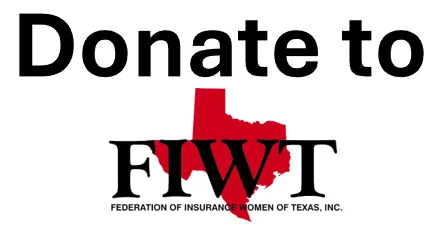
CERTIFIED INSURANCE PROFESSIONAL OF TEXAS PROGRAM
Building Skills for Today’s Insurance Professional
FIWT Certificate Program
A certificate is a non-degree program designed to provide students with specialized knowledge that is less extensive than, and different from, a college program. A certificate from FIWT demonstrates that the participant has completed a planned, sequential program of study in individual career skills that support the insurance industry and promotes enhanced standards of professionalism.
Name of the Program – Certified Insurance Professional of Texas
The Certified Insurance Professional of Texas (CIPT) program provides a series of essential career skills that support the insurance industry and promotes enhanced standards of professionalism.
To Earn the Designation, Participants Must:
Complete the six core subject courses (each two hours)
Maintain continuous FIWT membership
To Retain the Designation, Participants Must:
Recertify every two years by attending one of the following courses:
Core subject course
Update course (two courses required as updates are 1-hour courses)
Maintain continuous FIWT membership
Additional Notes:
One course to be offered at FIWT mid-year and one at FIWT convention
Updates will be given at both mid-year and convention – the same class will be offered at both and at the same time as the CIPT modules course. Updates will be one hour course at $25 each.
Courses do not have to be taken in order
Membership is required for certification but not for taking courses
Rotating classes will continue after course completes but may not be given in order
Code of Ethics for utilization – must be a member to use the designation
Renewals are needed every two years – total of two hours necessary every two years
Upon completion will receive a framed certificate and pin.
Course Attendance Fee:
FIWT Members $ 50 for each two-hour course
FIWT Members $ 25 for each one-hour update course
Non-Members $100 for each two-hour course
Non-Members $50 for each one-hour update course
Core Subject Programs:
1. Focus on Customer Service
2. Building Rapport for Effective Problem Solving
3. Keeping Yourself Professional – What Does That Mean?
4. Business Etiquette To Enhance Professionalism (In and Out of The Office)
5. Technology and Tools for Time Management
6. Back to Basics of Business Writing – Spelling, Punctuation, Vocabulary
Update Subject Programs:
Calming Upset Clients
Successful Negotiation Skills
Public Speaking Tips and Techniques
Basic Understanding of Financial Statements/ Budget Process
Basic Supervisory Skills
Core Subject Course #1 - Focus on Customer Service
Building rapport is the first step in creating a lasting relationship with coworkers and clients. This course is designed to provide basic tools in body language and verbiage that will enables greater and easier communication. There is no greater need to use rapport skills than when tackling a problem. This course also contains tools and techniques to assist the employee in basic problem solving, dealing with difficult and angry clients; learning to listen; and words that work for you and against you in customer service.
Learning the Language of Rapport
Matching Styles to Build Rapport
Characteristics of a Problem
Understanding Working Styles
Complaints—It’s Not All Bad
Core Subject Course #2 – Building Rapport for Effective Problem Solving
Building rapport is the first step in creating a lasting relationship with coworkers and clients. This course is designed to provide basic tools in body language and verbiage that will enables greater and easier communication. There is no greater need to use rapport skills than when tackling a problem. This course also contains tools and techniques to assist the employee in basic problem solving, dealing with difficult and angry clients; learning to listen; and words that work for you and against you in customer service.
Learning the Language of Rapport
Matching Styles to Build Rapport
Problem Solving Made Easy
Characteristics of a Problem
Understanding Working Styles
Complaints—It’s Not All Bad
Difficult Clients Are Still Your Clients
Core Subject Course #3- Keeping Yourself Professional – What Does That Mean
In order to succeed and move ahead in any industry, employees need to demonstrate professionalism. Professionalism does not mean wearing a particular style of clothing or having a particular appearance; rather, it means conducting oneself with responsibility, integrity, accountability, and excellence. It includes communicating effectively and appropriately while maintaining productive levels. This course provides basic information in understanding how to perform as a professional.
How Professional Are You
Treat Everyone as if they were Your Customer
Humor—A Success factor
First Impression
Staying Positive
Defining a True Professional
Core Subject Course #4 – Business Etiquette to Enhance Professionalism
(In and Out of the Office)
Business etiquette can be tricky, even for the most seasoned insurance professional. Your knowledge of what to do when the occasion arises may just be the edge you need to make the next promotion. Through this interactive program you will walk away with a better understanding of appropriate professional behavior in the workplace.
Etiquette Relating to Cubicle Space or Offices
General Office Etiquette
Top Business Etiquette Faux Pas
Speaking to Coworkers
Top Ten Business Etiquette Tips for Dining
Core Subject Course #5 – Time Management and Organization Skills
In today’s business environment it is all too easy to lose focus on what is the priority for the day. This course is designed to help employees become aware of how they use their time in organizing, prioritizing, and succeeding in completing the tasks at hand.
Developing Realistic Plans
Setting Priorities
De-cluttering your Office
Handling Correspondence
Keeping a Check on Emails
Recognizing Unnecessary
Learning to say NO
Activities and Interruptions
How to Create Daily/Weekly/Monthly Plans
Core Subject Course #6 – Back to Basics of Business Writing – Spelling, Punctuation and Vocabulary
With the growing use of text messaging and social media, the art of writing business correspondence has been greatly impacted. By using simple, clear, precise language and following a few basic writing rules, employees can become better communicators and enhance their professionalism.
How to Write for Busy Professionals
Choosing Words Carefully
Most Common Business Words
Keep it Simple
The Art of Effective Emails
Persuasive Writing
Remember Basic Grammar Rules






